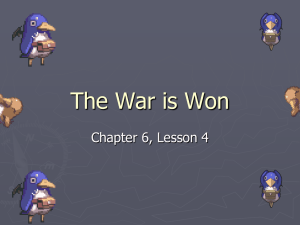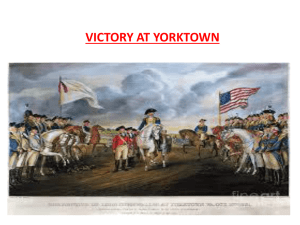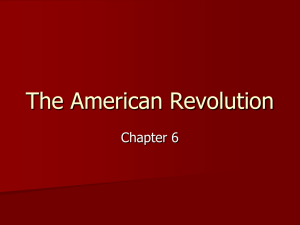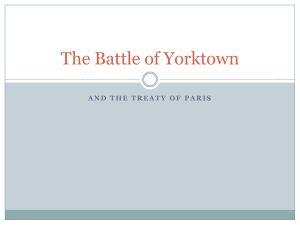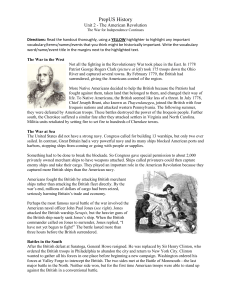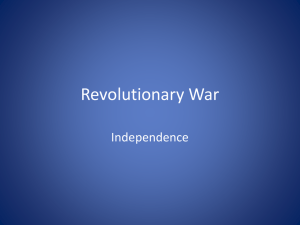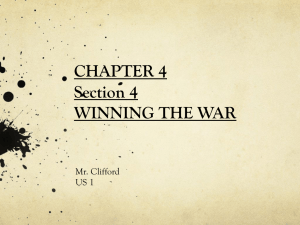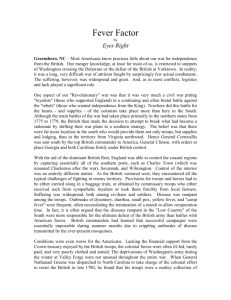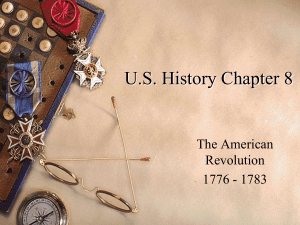Chapter 7.3 The Path to Victory
advertisement
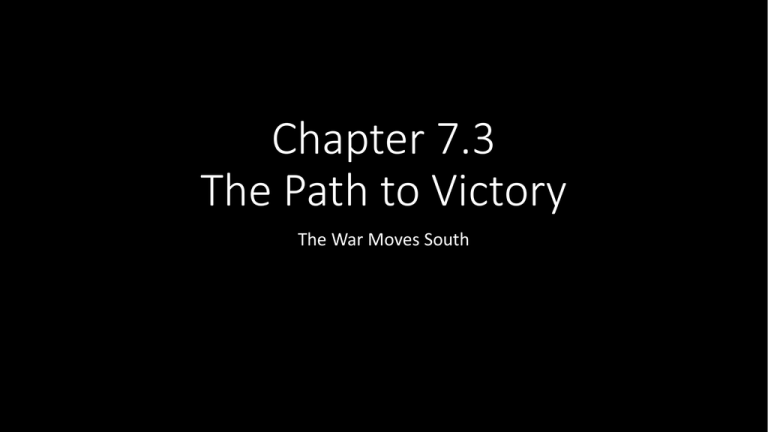
Chapter 7.3 The Path to Victory The War Moves South The British Change their Strategy: The War Moves South • After 3 years of fighting in the North, still no closer to victory • Had captured many important Northern coastal cities, but didn’t have troops to control the countryside • Believed most Southerners were Loyalists • Expected Southern slaves to escape and join them with the promise of freedom…thousands do, not all gain freedom Savannah and Charles Town Fall • December 1778, Brits capture Southern port of Savannah, GA & then most of GA • 1780, Brits led by General Henry Clinton surround forces at Charles Town, S.C. • Americans Lose almost their entire Southern Army • Worst Defeat of the War! • General Horatio Gates to form a new Southern Army • Baron de Kalb led the core of Continental soldiers, Gates adds about 2,000 new and untrained militia • Head to Camden, South Carolina to challenge Cornwallis (Clinton was back in NY) Battle of Camden: August 1780 • Gates and Army run into British troops outside Camden • In no condition to fight….out of supplies, half-starved. • Gates puts inexperienced militia along part of the frontline instead of experienced soldiers • Panicked and fled • Gates flees with them! • De Kalb remains and fights until mortally wounded • Gates removed • American spirits fall to a new low! Guerrilla Warfare • Americans were defeated at Charles Town and Camden, but Brits still couldn’t control the South • Countryside was hostile and filled with more rebel sympathizers than Loyalists • Attacks on British messengers, hard to keep in touch with bases on the coast • Francis Marion “Swamp Fox” • Led a band of about 20 men out of the swamps, cutting British supply lines General Greene Takes Charge • Nathanael Greene put in charge of the Southern Army • Cowpens victory for the Americans, proving they had mastered formal battle tactics of the British • Cornwallis pursues Greene’s main army • Americans knew the land better and his strategy was to lead them on a chase and tire them out, only fight when they could inflict severe losses on the British • ****Cornwallis lost so many men at the Battle of Guilford Court House that he retreated to Wilmington on the coast • Cornwallis realizes there are more active Patriots than Loyalists in the South End of the War: Setting A Trap • 1781, Cornwallis, frustrated, turns to Virginia, where he believes rebels are receiving their supplies from • August 1781, set- up base at Yorktown, VA to receive supplies from NY • Washington takes opportunity to trap him on the peninsula • Admiral de Grasse, operating with a powerful French fleet offers to join the fight, Washington quickly accepts, marches 300 miles with Rochambeau’s French forces from New York. Admiral De Grasse arrives from the West Indies and blockades Chesapeake Bay • Lafayette had arrived in March and sent a message of a potential launch against Cornwallis’ forces, unknown to him, the troops and French fleet were already on their way! He commanded a division of American troops during the assault on Yorktown. • British ships can’t reach Yorktown or bring supplies • British build redoubts (small forts) to protect themselves, but cannons bombard Yorktown • Cornwallis is surrounded and October 19, 1781, Yorktown, Cornwallis surrendered about 8,000 troops • French provide all of the seapower and ½ of the regular troops in the assault on Yorktown. • Last major battle of the war, although fighting continues in the South and on the frontier…Washington manages to keep his troops in place and states together America: The Story of Us • Yorktown: 6 Minutes, 39-45 • Note Joseph Plumb Martin Classzone.com • Animated Map • Chapter 7: Battle of Yorktown Why the Americans Won: See page 218 • Fighting for their lives, property, and political ideas • Popular support was strong • Leaders like Washington learned from their mistakes • Foreign allies, French, British, Russians, etc., • France supplied money and troops, Spain & Russia expanded the war • Communication, close to home, quicker decisions, made sure British couldn’t live off the land • Had fewer troops than the British, but filled the ranks with local militia. As many as 250,000 altogether may have fought for the Patriots…by 1781, British army had 54,000 Fond Farewells • Late 1783 the last British ships and troops left New York City. • Mixed emotions: “There was as much sorrow as joy…We had lived together as a family of brothers for several years, …had shared with each other the hardships, dangers, and sufferings incident to a soldier’s life; had sympathized with each other in trouble and sickness;… And now we were to be… parted forever.” -Joseph Plumb Martin, quoted in The Revolutionaries • Plumb Martin of Connecticut enlisted in 1776 at the age of 15. He experienced the terrible winter at Valley Forge and the winning battle at Yorktown.] • Washington wrote that the army’s endurance “through almost every possible suffering and discouragement for the space of eight long years, was little short of a standing miracle.”
